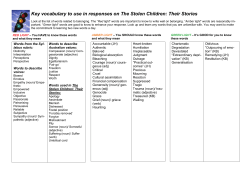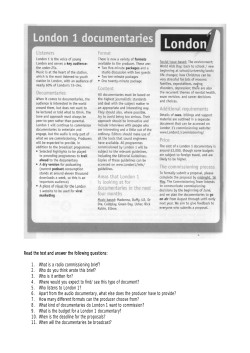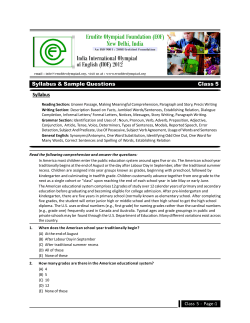
Lesson 1: in/definiteness, gender, adjectives and
Lesson 1: in/definiteness, gender, adjectives and nominal sentences In English, there are 4 major word classes: 1. Noun – naming words 2. Adjective – describing words 3. Verb – action (doing) words 4. Preposition Whereas in Arabic, there are 3: اِس ٌْم Verb ٌفِعْل Particle ٌحرْ ف َ 1. Noun 2. 3. Definiteness: Nouns Every noun must either be definite or indefinite. In English, we would refer to something definite using the definite article “the” – using “the” implies we have specified something. For example, if we say “I ate the apple” – we have identified a specific apple which has been eaten. Whereas, something which is indefinite, would be referred to with “a” or “an” because it does not pin-point a specific thing. For example, if we say “please pass me an apple” – we have not identified which apple we want, it could be any of the apples. In Arabic, the definite article corresponding to “the” is ْال The indefinite is shown by the use of tanween.* *Note: (some indefinite words do not take tanwin – you CANNOT try to give tanween if the vocab list shows no tanween, eg the words: َ )– أَوَّ لand آخر TIP: It is important to know which words do not take tanween so make a list of words like this and add to it as you go along to help you remember. 1 To make indefinite words definite To make an indefinite word definite (“the”), all you have to do is drop one of the final vowels of the tanween and prefix ٌْ الto the font of the word. ٌٌْالبِال ُد ٌبِال ُد The towns Prefix ٌبِالد towns ٌْال drop one of the final vowels of the tanween Take the indefinite word To make definite words indefinite To make a definite word indefinite (“a/an”), all you have to do is remove ٌْ الand double to final vowel to make tanween. ٌَرسول ٌَرسو ُل ٌالرَّسو ُل a messenger The messenger The messenger Double the final vowel to make tanween Remove ٌْال Take the definite word Gender In Arabic, words will grammatically be either masculine, or they will be feminine. There is no neutral in Arabic. Generally, feminine words will be shown as such by the taa’marboota ةat the end. Grammatical gender is not based solely on a words biological gender. Words which may “seem” masculine in meaning could actually be feminine grammatically! For example, take the word ُ – الرُّ جُوٌلَ ٌةmeaning “masculinity”. It may have a masculine meaning, however, grammatically it is actually a feminine word, as denoted by the taa’marbootah at the end! 2 Although most words that have a taa’marbootah at the end are visibly feminine, there are )ٌة, some words which although may not grammatically appear to be feminine (because no they are in fact so, through convention – For example ٌُ( األرْ ضearth) is in fact a feminine word. Also some words that may not have a taa’marbootah but will be grammatically feminine because of their meaning, for example ( أُ ٌمmother). . As a general rule, words should be treated as masculine unless you have a reason to treat them as feminine. As with all rules, some rules are made to be broken! There are a few words that although they have taa’marbootah, so therefore appear feminine, they are in fact masculine!!! The good news is that there are only a very small number of masculine words ending in taa’marbootah, and these are usually boys names, such as َ َحor عاوية مزة ِ ُم And the only masculine “feminine appearing” word which appears in the Qur’an is َخليفَة (successor/caliph) Making a masculine adjective feminine As is taught in the next section, sometimes it becomes necessary to change the grammatical gender of a word from masculine to feminine. ة To do this, all you need to do is add tar’marbootah ( ) onto the end of the word, and place a fatha on the letter before. For example: ٌبيرة َ َك ٌَكبيرة feminine ٌَكبِير masculine Adjectival Phrase Adjectives are words that describe a noun and come after the noun in Arabic. I.e.: ٌاآلخ ُر ٌاليَ ْو ُم ِ The last day 3 Like adjectives, an adjectival phrase describes nouns (or pronouns). Phrases add information to a sentence, but they only make complete sense as part of a sentence. A phrase does not contain a verb, and can perform the function of an adjective, an adverb or a noun. To make an adjectival phrase, we need a noun + adjective. The adjective must agree in 4 things with the noun it describes: 1 In/definiteness 2 Gender 3 Number 4 Case Does the noun Is the noun grammatically masculine or feminine? Is the noun singular, dual or plural? Is the noun majroor, mansoob or marfu? have الbefore or tanween on the end? (covered in lesson 2 and 13) (covered in lesson 3) As lesson 1 only deals with in/definiteness and gender, we will ignore number and case here. So, for example: If I want to say “The clear book”, I need to make an adjectival phrase. To do it: 1 Write the noun 2 Write the adjective after the noun ٌُال ِكتاب ٌال ِكتابٌُ ُمبين 1- Is it definite or indefine? 3 Look at the 4 things the adjective has to agree with in the noun 4 Make sure the adjective agrees in all 4 things and you have your adjectival phrase! –it has الso it is definite 2- Is it grammatically masculine or feminine? ٌُال ِكتاب – It does not have ةand there is no other reason that makes it feminine, so it is masculine 3- What number is it? 4- What case is it? ُ ال ِكتابٌُ ال ُم ٌبين The clear book Adjectival phrase Not dealt with in lesson 1 1- Noun is definite so adjective is definite 2- Noun is masculine so adjective is masculine 3- Number 4- case Not dealt with in lesson 1 4 Simple nominal sentence اِس ِميَّةٌ ُج ْملَ ٌة If an adjective agrees with the noun in only gender and number and not in case or definiteness, then you will not have an adjectival phrase, but instead an actual sentence! A simple nominal sentence is known in Arabic as Jumlah ismiyyah اِس ِميَّةٌ ُج ْملَ ٌة It is also referred to as an equational sentence, because in its most basic form, its construction can be represented with the equation: The X is Y The X (is) This is the subject Y No need for a verb “to be” in Arabic present tense ُال ُم ْبتَ َدٌأ This is the noun of the sentence Will always be definite Known as the predicate َ ٌالخبَ ُر The predicate tells you something about the subject Will always be indefinite and must agree with the X in gender and number Indefinite Predicate (the adjective) Definite Subject (the noun) ٌال ِكتابٌُ ُمبين The book is clear The X is Y The difference between an adjectival phrase and a nominal sentence: Adjectival Phrase Nominal Sentence ُ ال ِكتابٌُ ال ُم ٌبين ٌال ِكتابٌُ ُمبين The clear book The book is clear The X is Y Agrees in all 4 things Agrees only in gender and number 5 Lesson 1: Quick revision summary To make word definite: Drop one of the final vowels of the tanween and prefix ٌْالبِال ُد ٌْ الto the font of the word. ٌبِالد To make word indefinite: Remove ٌْ الand double to final vowel to make tanween. ٌَرسول *Remember: some words cannot take tanween ٌالرَّسو ُل Grammatical gender: Treat words as masculine unless have a reason to treat as feminine (ie: ةor are feminine through convention or meaning) To make a masculine adjective feminine ة ٌَكبِير Add taa’marbootah ( ) onto the end of the word, and place a fatha on the letter before. ٌبيرة ٌَ َك Adjectival Phrase: Noun + adjective Adjective must agree with noun in all 4 things: 1- In/definiteness 2- Gender 3- Number 4- Case ُ ال ِكتابٌُ ال ُم ٌبين The clear book Nominal Sentence: The X is Y The X- is the subject (noun) – must be definite Is – no Arabic word needed Y– is the predicate (adjective) – must be indefinite ٌال ِكتابٌُ ُمبين The book is clear 6
© Copyright 2025














